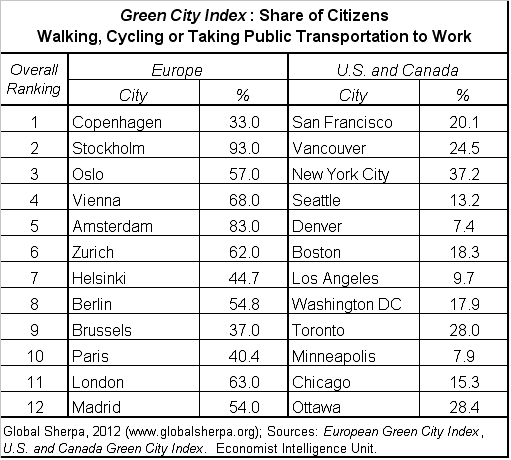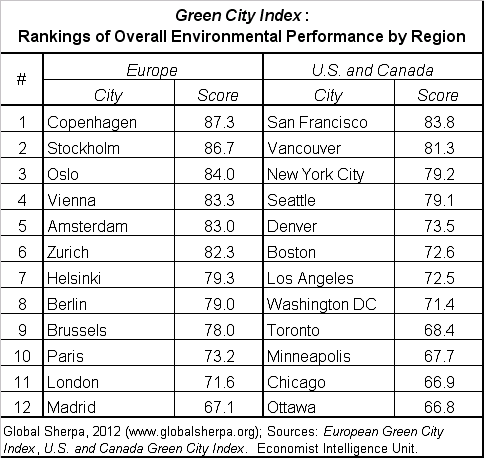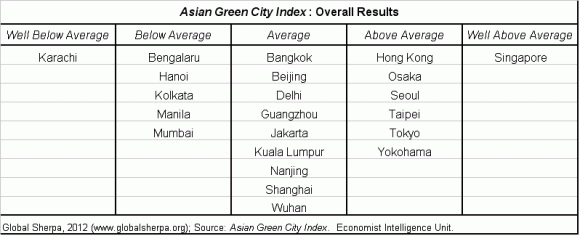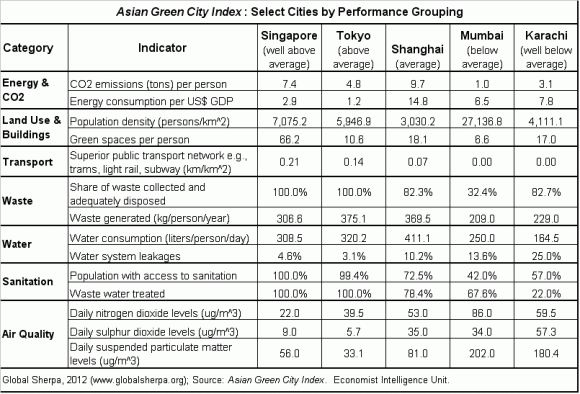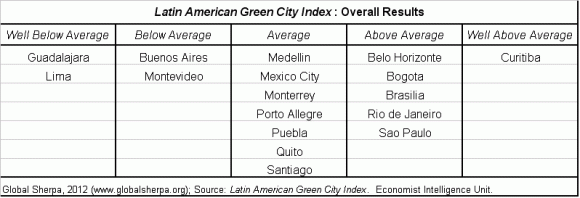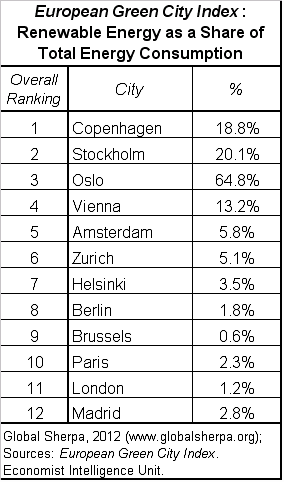Cities will shape the world’s environmental future according to the Green City Index, which evaluates the environmental performance of major cities around the globe. The Green City Index points to the urgent need and rare opportunity provided by the rapid expansion of cities in developing countries to set the world on a path to more sustainable development.
A product of the Economist Intelligence Unit (EIU) and sponsored by Siemens, the Green City Index is actually a collection of separate regional city rankings, including the African Green City Index, Asian Green City Index, European Green City Index, Latin American Green City Index and the U.S. and Canada Green City Index.
Rapid Urbanization and Growing Cities
In Asia, the massive migration from rural areas to cities is “unprecedented in human history” according to the Asian Development Bank (ADB). To keep pace with economic development, every day growing cities in developing countries across Asia need to add a total of 20,000 new dwellings, 250km of new roads and infrastructure to deliver 6 million more liters of potable water, according to the ADB’s calculations.
Sustainable Cities: Great Opportunity and Risk
The world’s dramatic urban transformation is a great opportunity and risk. Through smart urban planning and the adoption of sustainable consumption habits, the world has a rare chance to choose a more sustainable path for development. On the other hand, failures to invest wisely in sustainability on the front end would forgo healthier environments and eventually force downstream scrambles for cures that are bound to be far more costly and likely less effective.
Environmental Performance and Wealth
Encouraging data suggest economic development leads to better environmental performance in the long run. In the European Green City Index, an increase of 1,000 Euros in a city’s average economic output per person translates to a higher overall index score of about two-thirds of a point. Wealthier cities can afford to invest more in green infrastructure and professional staff to develop, implement and monitor environmental policy.
Regional Comparisons
The separate regional indexes shy away from directly comparing the environmental performance of cities in different parts of the world. Nevertheless, data from the various reports support the expectation that cities from developed countries in Europe and North America generally outperform those from developing countries in Asia, Latin America and Africa.
In Europe, Copenhagen, Denmark, Stockholm, Sweden and Oslo, Norway earn top marks for overall results and many of the individual performance categories. Vienna, Amsterdam and Zurich are close behind in spots four through six of the overall ranking. In the U.S. and Canada, the top four cities – San Francisco, Vancouver, New York and Seattle – lead the pack by a fair margin. The chart below shows the overall rankings of the top twelve cities from each regional index.
Eco-Friendly Living: Share of Residents Who Walk, Bike or Take Public Transportation to Work
A majority of residents choose the eco-friendly options of walking, bicycling or taking public transportation to work in most cities in the European Green City Index. In Stockholm and Amsterdam, an impressive 93 percent and 83 percent, respectively, of residents rely on one of these environmentally sustainable modes of transportation for commuting to work. Accordingly, Stockholm and Amsterdam take the top two spots in the Transport category of environmental performance. Amsterdam’s ranking should come as little surprise to those familiar with its unofficial status as a world capital of bike riding.
Somewhat curiously, the overall winner Copenhagen comes in third in the Transport category despite a relatively low 33 percent of residents who walk, bike or take public transportation to work. The table below shows the share of residents who choose eco-friendly commuting options for the top ranking cities in the European Green City Index and the U.S. and Canada Green City Index.
The U.S. is the world’s second largest emitter of greenhouse gases behind China, and U.S. per capita emissions far exceed those of China. The popularity of cars and correspondingly limited scale of public transportation in the U.S. are noteworthy culprits. New York is the only city in the U.S. and Canada Green City Index where the share of residents who walk, bike or take public transportation to work comes anywhere close to those of cities in the European Green City Index.
Asian Green City Index
The Asian Green City Index classifies cities into five levels of overall environmental performance. Singapore is the only Asian city in the index green enough to reach the top level of “well above average.” The six Asian cities in the next highest “above average” category include: Hong Kong, Osaka, Seoul, Taipei, Tokyo and Yokohama. The chart below shows the overall results for the cities in the Asian Green City Index.
Environmental Performance Categories and Indicators
The eight environmental performance categories for the Asian Green City Index include: Energy & CO2, Land Use & Buildings, Transport, Waste, Water, Sanitation, Air Quality and Environmental Governance. Each category is comprised of one to three indicators of environmental performance. The table below shows the scores for one example city from each of the five levels of overall results.
Singapore and Hong Kong
Both Singapore and Hong Kong score “above average” in six of eight categories. The biggest difference in their environmental performance relates to water. Hong Kong consumed in excess of 20 percent more water per person than Singapore and used water far less efficiently. Hong Kong’s water system had a leakage rate of 21 percent versus just 4.6 percent for Singapore. Singapore was one of three Asian cities to score “well above average” for its water performance and the only Asian city to rate “well above average” for waste performance.
Singapore’s strong environmental performance owes much to sound environmental policy and governance. The city-state’s ambitious environmental targets include: ensuring 70 percent of morning commutes use public transportation by 2020 (up from 59 percent in 2008); making sure 80 percent of buildings meet Singapore’s “Green Mark Certified” energy efficiency standards by 2030; and expanding park space by more than a quarter from 3,300 to 4,200 hectares by 2020.
Japan and South Korea
The three Japanese cities in the index – Tokyo, Osaka and Yokohama – and Seoul, South Korea earned overall ratings of “above average.” Japan‘s capital, Tokyo, was the only Asian city to score “well above average” for energy and CO2 performance. Osaka was the only Asian city to earn a “well above average” rating for transport performance. Along with Singapore, Tokyo and Yokohama made up the three Asian cities to rate “well above average” for water performance.
Seoul scored “above average” in six of eight categories and “average” in air quality performance. Waste performance was the one area where Seoul lagged behind with a “below average” rating. While Seoul collects and disposes of nearly 100 percent of its waste, it somehow generates an uncanny 996 kg of waste per person, nearly three times the Index average of 375 kg per person and the most of any urban center in the Asian Green City Index. For those seeking a job in the waste industry, Seoul could use the help.
China and India
The BRIC countries of China and India had five and four cities, respectively, in the Asian Green City Index. The Chinese cities in the Index are Beijing, Shanghai, Guangzhou, Nanjing and Wuhan. Indian cities in the Index include Delhi, Mumbai (Bombay), Kolkata (Calcutta) and Bengalaru (Bangalore).
With the exception of Delhi, the Chinese cities all earned “average” overall ratings, while the remaining three Indian cities had overall ratings of “below average.” Three of the five Chinese cities – Beijing, Wuhan and Nanjing – scored “above average” for water performance.
Consistent with China’s status as the world’s largest emitter of greenhouse gases, four of the five Chinese cities scored “below average” for their energy and CO2 performance. Shanghai was the only city in the Index with energy and CO2 performance that rated “well below average.”
Air Quality in Asia
Air pollution is a serious problem across Asia according to the Asian Green City Index. The average daily concentration of particulate matter among the 22 cities in the index is more than five times higher than the safe level recommended by the World Health Organization (WHO). China and India lag other Asian cities in air quality performance, with two Chinese and one Indian city rating “below average” and India’s bustling commercial center of Mumbai scoring “well below average.” While most Asian cities are taking measures to address the issue by reducing air pollution, air quality standards in Asia tend to be far more lenient than those in Europe, the U.S. and Canada.
Curiously, performance in the air quality category appears to correlate less with a city’s level of development than ratings for the other seven categories. Cities from five different sovereign entities – Japan, Malaysia, the Philippines, Singapore and Thailand – all earned “above average” ratings for air quality.
Latin American Green City Index
Like its Asian counterpart, the Latin American Green City Index classifies cities into five levels of overall environmental performance. The chart below shows the ratings for each city in the index.
Brazil
Hailed as a world model for urban planners and environmentalists, Curitiba, Brazil is the only Latin American city in the index green enough to reach the top level of “well above average.” Other Brazilian cities also fare well. Belo Horizonte, Brasilia, Rio de Janeiro and Sao Paulo all earn overall results of “above average.” Sao Paulo, Brazil is the only city in the index to rate “well above average” for energy and CO2 performance. Rio de Janeiro and Mexico City are the only two cities to score “well above average” for environmental governance.
Chile
Santiago, Chile has curiously divergent ratings that cancel out for an overall rating of “average.” Santiago sets the standard for transport performance in Latin America as the only city in the index to rate “well above average.” On the other hand, Santiago is also the only city to score “well below average” for energy and CO2 performance.
Argentina
Buenos Aires, Argentina’s overall rating of “below average” is surprisingly low considering the general relationship between wealth and environmental performance. Buenos Aires and Gaudalajara, Mexico are the only two cities to rate “well below average” in the water category. Along with a number of other cities in the index, Buenos Aires’ performance also lags behind in waste and sanitation with ratings of “below average.”
Renewable Energy Usage
One common area for improvement for nearly all of the cities in each regional index is the use of renewable energy. Even for European cities, the share of renewable energy in a city’s total energy consumption is generally low, ranging from 0.6 percent for Brussels, Belgium to 64.8 percent for Oslo, Norway. Unlike many other cities, Oslo benefits from natural advantages that include abundant rainfall and a mountainous countryside, which contribute to an ample supply of clean hydroelectric power. Other than Oslo, the next highest users of renewable energy are top-ranking Copenhagen and Stockholm, which each derive about one-fifth of their total energy consumption from renewable sources. Denmark’s national government has a climate change strategy that aims to raise the share of renewable energy to 30 percent of total consumption by 2025. The chart below shows the percentage of renewable energy consumed by the top ranking cities in the European Green City Index.
Environmental Policy and Governance: Oslo, Norway
Environmental policy and governance play important roles in a city’s environmental performance. Third-ranked Oslo, Norway has one of the most ambitious targets for reducing carbon emissions in the European Green City Index. By 2030, Norway’s capital city aims to reduce emissions by 50 percent from 1990 levels. Oslo’s 100 million Euro Climate and Energy Fund was funded by a tax on electricity and provides a 50 percent grant for converting oil-powered heaters to biofuels. The city has aggressively promoted environmentally friendly district heating powered by hydroelectric power and biofuels. Oslo also plans to convert city busses to biofuels and has reduced traffic by 4-7 percent by introducing a congestion charge.
What Can We Learn?
Cities that invest in good environmental governance and make sound environmental policy reap the benefits of environments that are healthier and more sustainable. While wealth correlates with good environmental performance, even less wealthy cities in developing countries have found economical ways, such as planting trees and incentivizing sustainable behavior, to reduce their environmental impact and improve living conditions. Cities around the world, especially rapidly growing urban areas in developing countries, should take note and make every effort to apply the valuable lessons and best practices from others’ experiences in order to set a course for a healthier, more sustainable future.
Related articles and content:
Global Sherpa city and country profiles and topic pages: World Cities, New York City, Tokyo, BRIC Countries, China, India, Brazil, Development, Sustainability, World Rankings
Resilient Cities: Climate Adaptation & Urban Development
The Great Global Water Squeeze
Infrastructure Fuels Growth in BRIC Countries
Scoring and Ranking the World’s Environmental Performance

